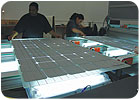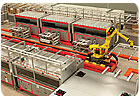
Ironically, Wisconsin’s first solar panel manufacturer is located in the shadow of a coal-fired power plant. The 40,000-square-foot Helios Solar Works facility also sits on the site of Milwaukee’s former stockyards. It’s a shining example of how 21st century renewable energy technology may soon surpass 19th century processes.
The Helios plant is less than a mile from downtown Milwaukee in the Menomonee Valley. A century ago, when Milwaukee was the “workshop of America,” the Menomonee Valley was home to a wide variety of heavy-duty manufacturers. Its leading employer was the Milwaukee Road, which mass-produced thousands of freight and passenger railcars, including the famous 1930s-era Hiawatha streamliner, at a huge complex called the Milwaukee Shops.
Helios, a start-up company founded by a group of entrepreneurs who came from a wide variety of industries, including printing, opened its doors in late February. The plant assembles monocrystalline solar modules that are used in residential, commercial, industrial and utility-based solar electric systems.
“We are focusing on customers who value openness, one-on-one customer service, and on-time delivery-three elements of our business model that differentiate us from competitors, especially low-cost importers,” says Steve Ostrenga, chief executive officer. “[We] believe that solar electricity can help meet global demand for clean, safe and economical energy while also serving as a driving force for renewed American manufacturing strength.
“Our modules are manufactured right in the heart of America’s manufacturing base,” adds Ostrenga. “That offers our customers both tangible and intangible benefits that non-American manufacturers cannot offer.
“With its commitment to renewable energy and tradition of manufacturing expertise, Milwaukee is the ideal location for Helios Solar Works to pursue our vision,” Ostrenga points out. “There is a strong tradition of energy-related innovation in the area. In addition, both Milwaukee and Madison have been designated as Solar America Cities by the U.S. Department of Energy-evidence of Wisconsin’s commitment to a solar-powered future.”
Helios currently operates a 40,000-square-foot assembly line with 12 operators. But, the company plans to add at least two more lines in the near future as production ramps up. “We anticipate creating more than 50 new jobs during our first three years of operation,” says Ostrenga.

A robot attached to a track moves solar panels into and out of six laminators. Photo courtesy Helios Solar Works
Automated Assembly Process
Unlike some of its competitors, Helios builds modules that use 156-square-millimeter monocrystalline solar cells, which are sourced from an American supplier. Monocrystalline silicon is one of the best understood engineering materials in the world, because it’s widely used in the electronics industry.The monocrystalline substrate is essentially identical to the integrated circuit substrate in terms of raw material content and crystal growth. That ensures predictable processing conditions and consistent yields. Wafers are processed into solar cells through a multistep process of etching, doping, coating and applying electrical contacts.
“There isn’t an assembly or production advantage with using monocrystalline, but there is a product performance advantage,” says John Kivlin, chief operating officer. “Our solar modules offer higher efficiency and lower installation costs than other alternatives.” That allows Helios to provide a 25-year warranty of 90 percent of minimum rated power for 10 years, and 80 percent for an additional 15 years.
Kivlin, who holds an electrical engineering degree, previously worked at Motorola. He says the photovoltaic module assembly process is both similar to and different than what he experienced in the electronics industry.
“It’s similar in that it is a highly automated in-line process,” notes Kivlin. “But, [we’re] making a product that is 80 times the weight with one-tenth the components and two-thirds the process steps, with a throughput rate measured in minutes rather than seconds.”
A solar module is comprised of an array of solar cells that are soldered together in series connections, encapsulated in a physically durable and waterproof package, and then placed in an anodized aluminum frame.
Helios currently builds two types of products on its assembly line: the smaller and lighter 6T Series module and the larger 7T2 Series module. The 6T module, which contains 60 solar wafers, weighs 54 pounds, measures 39 by 66 inches and generates 250 watts.
The slightly larger 7T2 module weighs 57 pounds and contains 72 solar wafers. It generates 300 watts and measures 39 by 78 inches. Helios is currently developing a 96-cell module that will generate 400 watts.
Automation plays a key role in Helios’ production strategy. “We use an advanced, automated manufacturing platform that allows us to reduce operational costs and remain competitive,” says Kivlin. “The equipment occupies a very small footprint and provides the right balance between high-end automation and basic automation.”
Typically, it takes about 40 minutes for a single panel to be built. The U-shaped assembly line is divided into six basic workstations: cell soldering or stringing; interconnection; lamination; junction box attachment; frame press; and flash test.
During the stringing process, solar cells are automatically soldered into strings and placed on soft, flexible sheets of ethylene vinyl acetate (EVA). “We have a proprietary stringer-tabber that produces at a best-in-class quality level,” says Kivlin.
Two material handling robots are used in the process. A mini robot picks up individual solar cells at the front end of the stringing operation. Next, an overhead-mounted robot uses a vacuum gripper to pick and place strings containing 10 or 12 solar cells and align them in six rows on a sheet of EVA.
A conveyor moves modules to the manual interconnection workstation. Operators equipped with soldering irons connect the six strings into three strings, adding a second sheet of EVA and a Tedlar laminant backsheet.
Lamination is the most time-consuming step in the assembly process. Six laminators apply heat and vacuum to encapsulate the cells, and bond the glass to the cells and to the backsheet. A robot attached to a track moves the panels into and out of the laminators.
Operators apply a silicone pottant as they attach and solder a junction box and cable to the backsheet. Next, operators apply sealant and press an aluminum frame around the glass edges for easy handling.
Once the modules are assembled, they are flash tested under standard test conditions to ensure performance and customer satisfaction. During the flash test, high-powered bulbs housed in a 26-foot high vertical tower are used to simulate the sun.
Finally, a six-axis robot stacks modules for shipment to distributors, systems integrators and value-added resellers throughout the United States and Europe. A
